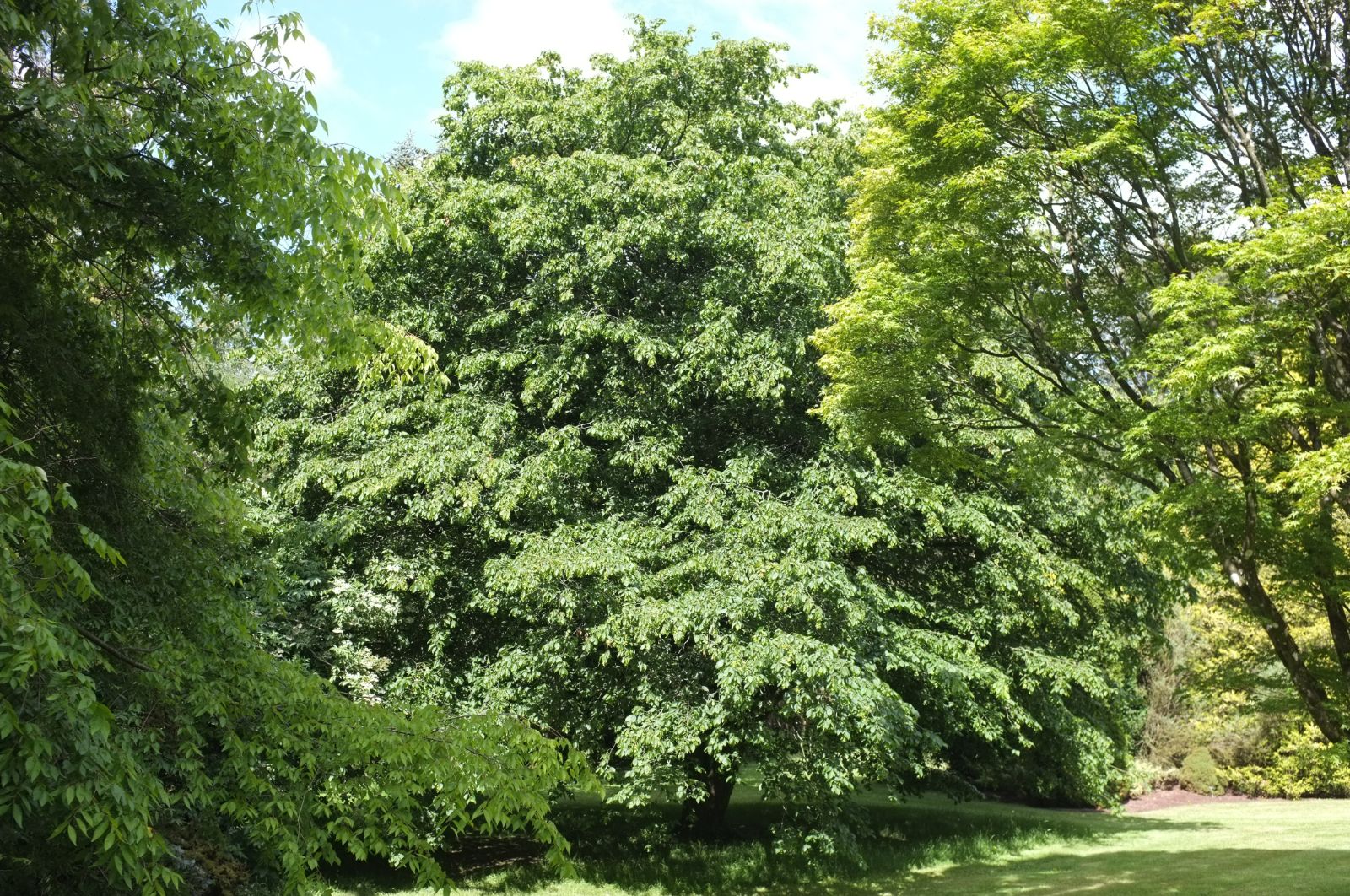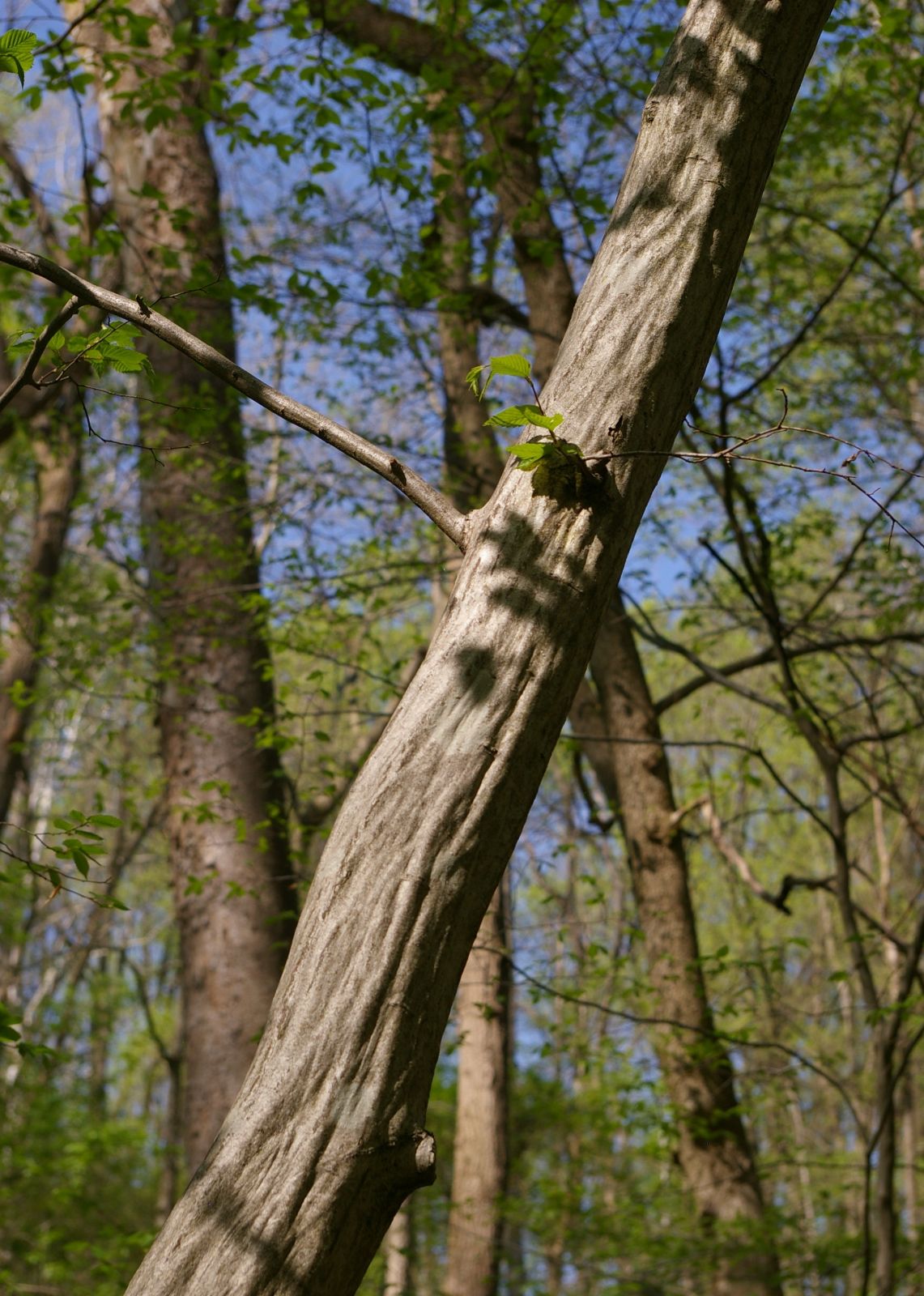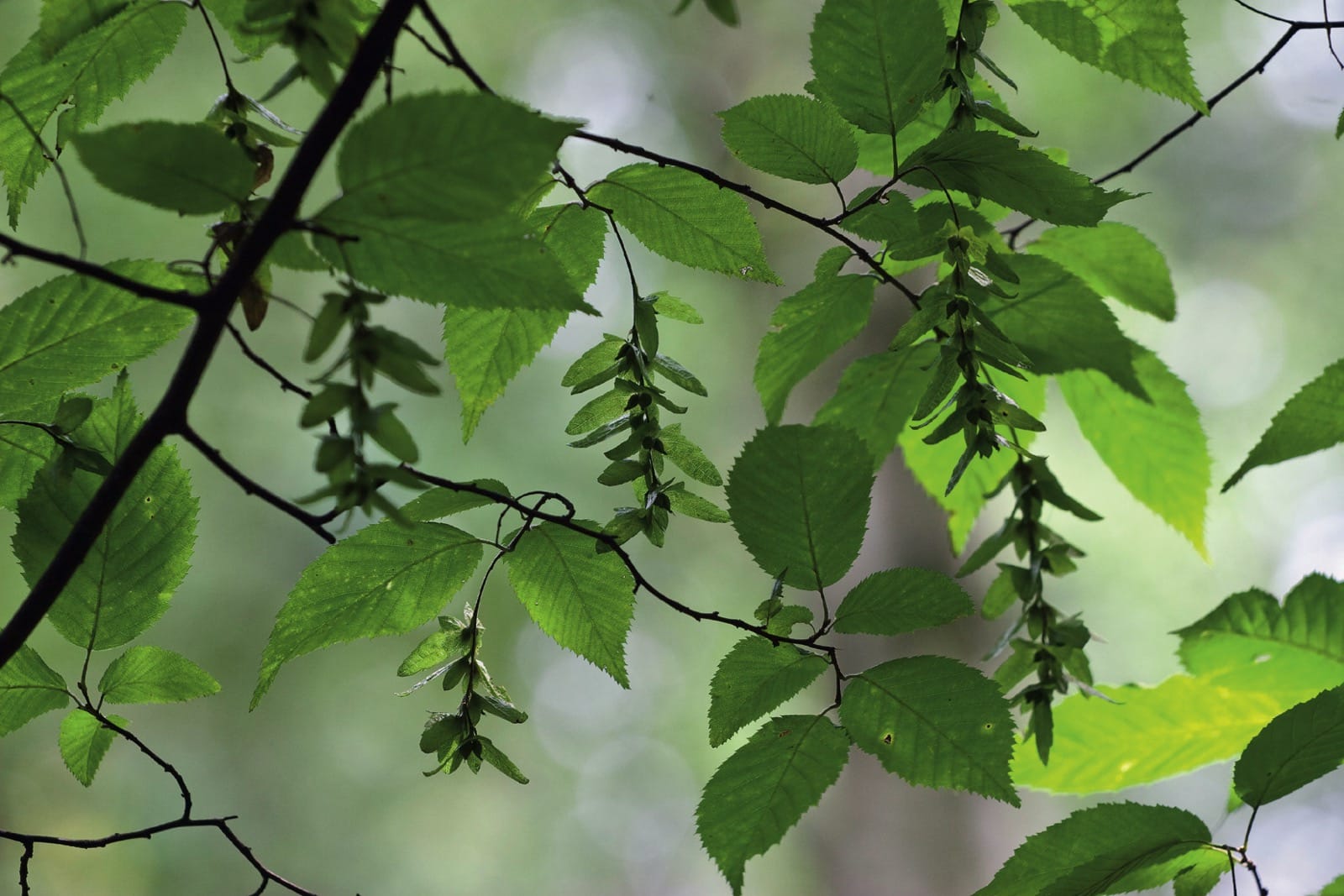Carpinus caroliniana
Sponsor
Kindly sponsored by
Lord and Lady Aldington
Credits
Owen Johnson (2022)
Recommended citation
Johnson, O. (2022), 'Carpinus caroliniana' from the website Trees and Shrubs Online (treesandshrubsonline.
Genus
Common Names
- American Hornbeam
- Blue Beech
- Ironwood
- Musclewood
- Water Beech
Synonyms
- Carpinus americana Michx.
Infraspecifics
Other taxa in genus
- Carpinus betulus
- Carpinus cordata
- Carpinus faginea
- Carpinus fangiana
- Carpinus fargesiana
- Carpinus hebestroma
- Carpinus henryana
- Carpinus japonica
- Carpinus kawakamii
- Carpinus laxiflora
- Carpinus londoniana
- Carpinus mollicoma
- Carpinus monbeigiana
- Carpinus omeiensis
- Carpinus orientalis
- Carpinus polyneura
- Carpinus pubescens
- Carpinus rankanensis
- Carpinus × schuschaensis
- Carpinus shensiensis
- Carpinus tropicalis
- Carpinus tschonoskii
- Carpinus turczaninovii
- Carpinus viminea
A spreading tree to 12 m; bole often short and fluted. Bark smooth, grey, with some fissures in age. Shoots grey-brown, slender, zig-zag, with silky hairs at first; buds short, bluntly ovate, 3–4 mm. Leaves ovate, 3–12 × 2–6 cm, base rounded to cordate, apex rather shortly pointed; lateral veins in c.14 pairs, each tipped by a fine tooth between which are several teeth variably smaller; silky-hairy when young, the hairs persistent under the veins; petiole 6–12 mm, hairy. Autumn colour yellow to red. Male catkins 2–6 cm. Female catkin expanding to 3–7(–12) cm in fruit; bracts not crowded, 2–3.5 × 1.4–2.8 cm, 3-lobed, asymmetrical, the inner lobe very small and the central lobe often toothed on one side only. (Furlow 1997; Bean 1976).
Distribution Canada Ontario, Quebec United States Alabama, Arkansas, Connecticut, Delaware, Florida, Georgia, Illinois, Indiana, Iowa, Kentucky, Louisiana, Maine, Maryland, Massachusetts, Michigan, Minnesota, Mississippi, Missouri, New Hampshire, New Jersey, New York, North Carolina, Ohio, Oklahoma, Pennsylvania, Rhode Island, South Carolina, Tennessee, Texas, Vermont, Virginia, West Virginia, Wisconsin
Habitat Lowland forests, on heavy soils, by streams and on flood-plains; to 200 m asl.
USDA Hardiness Zone 3
RHS Hardiness Rating H7
Conservation status Least concern (LC)
Carpinus caroliniana occupies the same role in the lowland forests of eastern North American as C. betulus does across Europe but, in competition with a much wider variety of tall-growing trees, it is more precisely confined as a slow, shade-tolerant understorey plant of heavy, difficult soils and flood-plain woodlands; it never grows as big as C. betulus, and probably does not live so long. It produces a similarly hard and heavy timber, and had numerous medicinal uses among Native American tribes (Furlow 1997). Plants from the northern end of the species’ range are rather hardier than C. betulus, but the species is less pollution tolerant in urban situations (Dirr 2009). Like so many American trees, the autumn colour can be brilliant, orange and scarlet tints mixing with the European hornbeam’s characteristic yellow. The fruit bract is less symmetrical than the European tree’s, and the side-lobes are less developed. The foliage and the general aspect are very similar, but the shorter and less pointed winter buds of the American tree offer a useful differentiating feature (Bean 1976); until late summer however, next winter’s buds are seldom sufficiently developed to be distinguishable. Recent phylogenetic analyses (Dong et al. 2022) have indicated that C. caroliniana is not very closely related to other members of the genus, except for the Mexican C. tropicalis – as might have been expected, given these taxa’s long isolation in the New World. The closest Old World allies seem to be not C. betulus but the east Asian species C. viminea and C. laxiflora, whose fruit-bracts are shaped similarly.
Carpinus caroliniana is stated to have been introduced to Britain in 1812 (Bean 1976), which seems a little late for an abundant tree from its part of the world, but this date was probably derived from a reference within Arboretum et Fruticetum Britannicum (Loudon 1838) to a tree at Trentham Park in Staffordshire which was supposed to be have been about 25 years old when J.C. Loudon sent out his requests for information and measurements to the leading collections of the time. However, as this tree was 11 m tall and 31 cm dbh by this stage, it must have been older (or was really a more vigorous example of C. betulus). Another specimen about ten years younger and only 4 m tall was also recorded by Loudon from Dalhousie Castle in southern Scotland (Loudon 1838). Neither example has been recorded since, and the next evidence for the American Hornbeam’s cultivation in Europe may not be until 1916, when five were planted at the Royal Botanic Gardens, Kew; the single old tree which survived near the Elizabeth Gate until 2010 (when it was 12 m × 36 cm dbh) lacked a confirmed planting date and may or may not have been one of these (Tree Register 2022), but it does seem true that C. caroliniana has a high failure rate in north-west Europe. The species has certainly never been more than a collector’s tree here, and, even in collections, some examples which have long been labelled as the American tree turn out on closer inspection to be ordinary C. betulus: this is true of the fine example planted in 1929 at Clay Island in the Westonbirt National Arboretum (Tree Register 2022). C. caroliniana might prefer the longer warmer summers of southern Europe, but there are too few examples for this hypothesis to be tested. In recent decades, the species has been caught up in the general enthusiasm for planting hornbeams in big gardens, particularly in England, and this slightly more widespread presence may finally allow it to prove its worth in Europe.
Across the larger part of the native range plants with scattered dark glands under their leaves are distinguished by some authorities as subsp. virginiana (Marshall) Furlow – a combination which was not published until 1987. (The variant is also occasionally known as C. virginiana (Marshall) Sudworth, but should not be confused with the closely related hop-hornbeam Ostrya virginiana (Mill.) K. Koch, which shares the vernacular name ‘Ironwood’ and was long known as C. virginiana Mill. The plant first described by the American botanist Humphry Marshall in 1785 as ‘C. betulus virginiana’ was C. caroliniana sensu lato, thought the example in question may have belonged within subsp. virginiana.) Hornbeams from the south-eastern coastal United States and the lower Mississippi valley (subsp. caroliniana in Furlow’s understanding of the species) lack the dark glands and tend to have smaller, longer-tipped leaves with finer secondary teeth, but there is a broad band of introgression from the Carolinas south to northern Georgia and westward to Missouri, Arkansas and southeastern Oklahoma (Furlow 1997). In collections, C. caroliniana has seldom been identified to subspecific level but most examples, particularly in colder climates, are likely to belong to subsp. virginiana.
In North America various clones have been selected for a more upright habit, suited to use as street trees, for general hardiness and for reliable autumn colour. A couple of different cultivars are grown in European collections and are now offered by a few specialist nurseries here.
'Ascendens'
An example of what is probably the first fastigiate form of American Hornbeam to have been selected was sourced by the Morton Arboretum in Illinois from Rochester, New York, around 1918, and is still represented in the garden by a 1940 repropagation (Hatch 2021–2022). ‘Ascendens’ may never have been commercially distributed. Like the ‘fastigiate’ forms of European Hornbeam, it has erect branches but its crown becomes quite broad.
'CCSQU'
Synonyms / alternative names
Carpinus caroliniana PALISADE™
A narrow, steeply-branched selection from Georgia, USA (Dirr 2009). The dark green leaves turn yellow in autumn (Hatch 2021–2022).
CLARYNETTE®
A vigorous upright clone selected in Georgia, USA, with bright orange and red autumn colour (Stewart 2010). Randy Stewart suggests it can reach 20 m, which is considerably taller than the wild species is likely to grow.
COLLYNAIR®
A slightly broader selection than CLARYNETTE®. Both clones are sold in the United States by Moon’s Tree Farm in Georgia (Moon’s Tree Farm 2022).
'J N Globe'
Synonyms / alternative names
Carpinus caroliniana BALL O'FIRE™
A semi-dwarf sport selected by Michael Yanny for Johnson’s Nursery in Wisconsin in 2000; it grows slowly into a dense globe to 5 m tall, with exceptional red, orange and yellow autumn colours (Dirr 2009; Hatch 2021–2022).
'J N Select A'
Synonyms / alternative names
Carpinus caroliniana FIRE KING™
Selected for its hardiness in 2003 by Michael Yanny at Johnson’s Nursery in Wisconsin; a tree with a rounded habit (Stewart 2010).
'J N Upright'
Synonyms / alternative names
Carpinus caroliniana FIRE SPIRE™
Carpinus caroliniana FIRESPIRE™
Selected in 1993 by Michael Yanny for Johnson’s Nursery, Wisconsin; a narrow, slow tree whose autumn colours range from orange to burgundy (Dirr 2009; Hatch 2021–2022).
'JFS-KW6'
Synonyms / alternative names
Carpinus caroliniana NATIVE FLAME®
An ovoid tree with dark green leaves turning a good orange-red in autumn, sold by J. Frank Schmidt and Son of Oregon from 2015 (Hatch 2021–2022).
'MY Select Strain'
Synonyms / alternative names
Carpinus caroliniana WISCONSIN RED™
An autumn colouring selection from Michael Yanny in Wisconsin, sold by 2021 (Hatch 2021–2022).
'Pyramidalis'
An old, rather upright selection represented at the Arnold Arboretum in the US and the Sir Harold Hillier Gardens in the UK, where a 1982 planting was 10 m tall by 2017 (Tree Register 2022; Dirr 2009). This is presumably the clone described by Bernheim Arboretum under the extraordinary name ‘Pyranudakus’ (Bernheim Forest and Arboretum 2022).
'Red Fall'
A clone selected for its autumn colour and one of only two to be sold (by a few specialist suppliers) in Europe, not in North America (Burncoose Nurseries 2022). The occasional sale name ‘Red Hill’ is apparently a corruption.
'Sentinel Dries'
An upright selection (Frank P Matthews 2022) now sold quite widely in Europe, but not in North America.
'Stowe Cascade'
A semi-weeping sport found near Charlotte, North Carolina, and originally grown at the Daniel Stowe Botanical Garden (Dirr 2009). An example at the J.C. Raulston Arboretum in South Carolina has made a poor, untidy plant.
subsp. virginiana (Marshall) Furlow
Synonyms
Carpinus virginiana (Marshall) Sudworth [1893; not Miller 1768]
Subsp. virginiana has an ovate to elliptical leaf, 8–12 cm long, with a caudate or acuminate apex and brown glands on the lower surface. The secondary teeth on the margins are almost as long as the primary teeth. In contrast, the type has an oblong to ovate leaf, 3–8.5 cm long, with an acute or obtuse apex and no abaxial glands. The secondary teeth are small and blunt. (Furlow 1997; Grimshaw & Bayton 2009).
Distribution
- Canada – Ontario, Quebec
- United States – from Maine and Michigan south to Georgia and west to eastern Oklahoma (generally north of the type)
RHS Hardiness Rating: H4
USDA Hardiness Zone: 3b
Taxonomic note Several North American taxonomists do not recognise infraspecifics within C. caroliniana, but here we follow both Plants of the World Online (2022) and Flora of North America (1997) in accepting this taxon. The ranges of the two subspecies overlap and hybrids with intermediate features are common from long island south along the Atlantic coast to North Carolina, and inland from northern south Carolina to the Mississippi valley (Furlow 1997).
Discussed under the main entry for C. caroliniana. Most plants in European cultivation probably belong here.
'Uxbridge'
Synonyms / alternative names
Carpinus caroliniana RISING FIRE™
An upright clone of good shape found at Uxbridge, Ontario, near the northern edge of the species’ range, and sold by J. Frank Schmidt and Son of Oregon from 2016; it is very hardy and has good red autumn colour with some yellow (Hatch 2021–2022).








